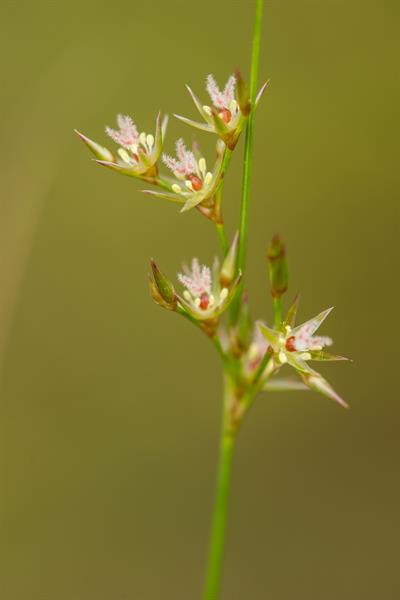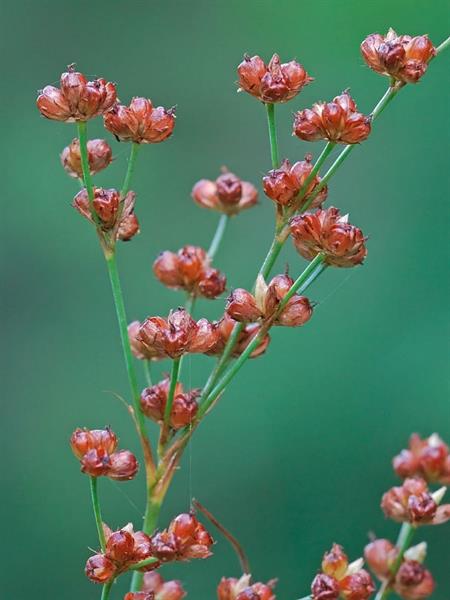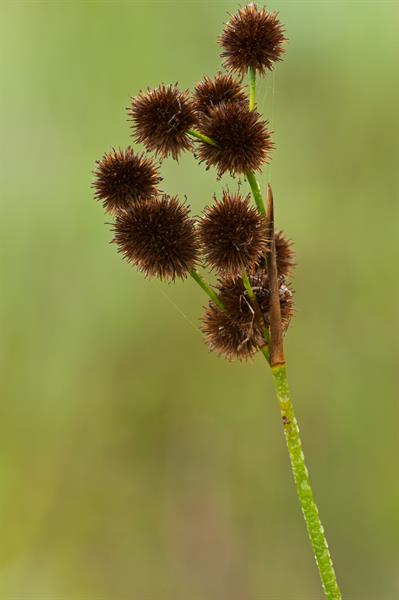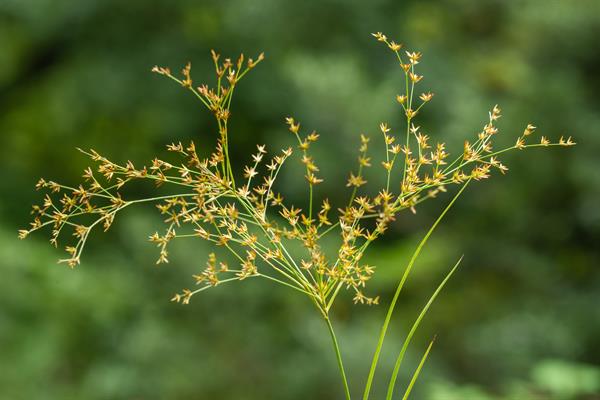
Contributed by W.M. Knapp and B.A. Sorrie
A genus of about 250-300 species, herbs, of cosmopolitan distribution.
subgenus Juncus, section Juncus: acutus ssp. leopoldii, roemerianus
subgenus Juncus, section Graminifolii: biflorus, filipendulus, longii, marginatus, repens
subgenus Juncus, section Iridifolii: polycephalos
subgenus Juncus, section Ozophyllum: acuminatus, brachycephalus, brevicaudatus, caesariensis, canadensis, megacephalus, militaris, nodosus, paludosus, pelocarpus, subcaudatus, torreyi, trigonocarpus, validus
subgenus Agathryon, section Tenageia: bufonius, ranarius
subgenus Agathryon, section Steirochloa: anthelatus, brachyphyllus, coriaceus, dichotomus, dudleyi, georgianus, gerardi, interior, secundus, tenuis,
subgenus Agathryon, section Juncotypus: balticus, filiformis, effusus ssp. effusus, effusus ssp. solutus, gymnocarpus, inflexus, pylaei
Key advice:Fruiting material is usually required for identification. The flowers consist of 6 tepals (an inner whorl and an outer whorl). The size and shape of the tepals, or the comparison in shape between the inner and outer can be important for identification. Stamen (filament and anther) size and shape can be informative for identification. These can be observed in plants with mature fruit by peeling back the tepals from the capsule. Capsule size, shape, and inner structure are important. Always try to observe mature capsules. To observe the to capsule inner structure to determine if the capsules of 3-, pseudo-3, or unilocular open one of the three capsule partitions (valves) and look into the capsule. If the inner capsule wall touches completely in the middle, that is 3-locular. If there is any space between the partitions, this is pseudo-3-locular, if there is no or only a minimal ridge formed on the inner capsule wall, this is unilocular. The flowers may be borne individually, with two small bracts subtending them or in groups (glomerules) with the flowers in tight groupings with the individual flowers difficult to distinguish. Leaf structure can be diagnostic to the sections of the genus. Leaves with complete leaf-septae can be felt by pinching the leaves at the leaf base (closest point to the culm/sheath) and sliding the pinched fingers toward the leaf apex. Complete leaf-septae will feel like a repeated series of ridges between softer internodes. Incomplete leaf-septae can be observed by looking down the leaf sheath and will appear as small ridges on the leaf surface and none of these septae will cross the entire leaf surface individually. Leaves without septae will appear as flat and unifacial. Complete specimens containing rooting material can be critical for identification, so be sure to collect below ground material.
Ref: Balslev In Kubitzki (1998b); Bridges & Orzell (2008); Brooks & Clemants (2000b) In Flora of North America Editorial Committee (2000); Brožová, Proćków, & Záveská Drábková (2022); Clemants (1990); Hämet-Ahti (1980); Kirschner (2002b); Kirschner (2002c); Knapp (2014); Knapp (2016) In Naczi & collaborators (2019); Knapp & Naczi (2008); Knapp & Poindexter (2022) In Weakley et al. (2022); Proćków & Záveská Drábková (2023); Záveská Drábková et al. (2003); Zika (2003); Zika (2013). Show full citations.
Hover over a shape, letter, icon, or arrow on the map for definition or see the legend. Data for arrows not developed for genera and families which may have species only occurring outside the flora area.
 © Gary P. Fleming | Juncus coriaceus | Original Image ⭷
© Gary P. Fleming | Juncus coriaceus | Original Image ⭷ © Gary P. Fleming | Juncus repens | Original Image ⭷
© Gary P. Fleming | Juncus repens | Original Image ⭷ © Bruce A. Sorrie | Juncus brachycarpus | Original Image ⭷
© Bruce A. Sorrie | Juncus brachycarpus | Original Image ⭷ © Keith Bradley | Juncus dichotomus | Original Image ⭷
© Keith Bradley | Juncus dichotomus | Original Image ⭷ © Gary P. Fleming | Juncus marginatus | Original Image ⭷
© Gary P. Fleming | Juncus marginatus | Original Image ⭷ © Christian Berg, some rights reserved (CC BY), uploaded by Christian Berg | Juncus maritimus source | Original Image ⭷
© Christian Berg, some rights reserved (CC BY), uploaded by Christian Berg | Juncus maritimus source | Original Image ⭷ © Keith Bradley | Juncus megacephalus | Original Image ⭷
© Keith Bradley | Juncus megacephalus | Original Image ⭷ © Gary P. Fleming | Juncus effusus ssp. solutus | Original Image ⭷
© Gary P. Fleming | Juncus effusus ssp. solutus | Original Image ⭷ © Keith Bradley | Juncus canadensis | Original Image ⭷
© Keith Bradley | Juncus canadensis | Original Image ⭷ © Erik Danielson | Juncus compressus source | Original Image ⭷
© Erik Danielson | Juncus compressus source | Original Image ⭷ © Jay Horn | Juncus repens source | Original Image ⭷
© Jay Horn | Juncus repens source | Original Image ⭷ © Keith Bradley | Juncus diffusissimus | Original Image ⭷
© Keith Bradley | Juncus diffusissimus | Original Image ⭷ © Chloe and Trevor Van Loon, some rights reserved (CC BY), uploaded by Chloe and Trevor Van Loon | Juncus filiformis source | Original Image ⭷ Warning: was NOT research grade.
© Chloe and Trevor Van Loon, some rights reserved (CC BY), uploaded by Chloe and Trevor Van Loon | Juncus filiformis source | Original Image ⭷ Warning: was NOT research grade.Feedback
See something wrong or missing on about Juncus? Let us know here: (Please include your name and email if at all complicated so we can clarify if needed.)
Cite as...